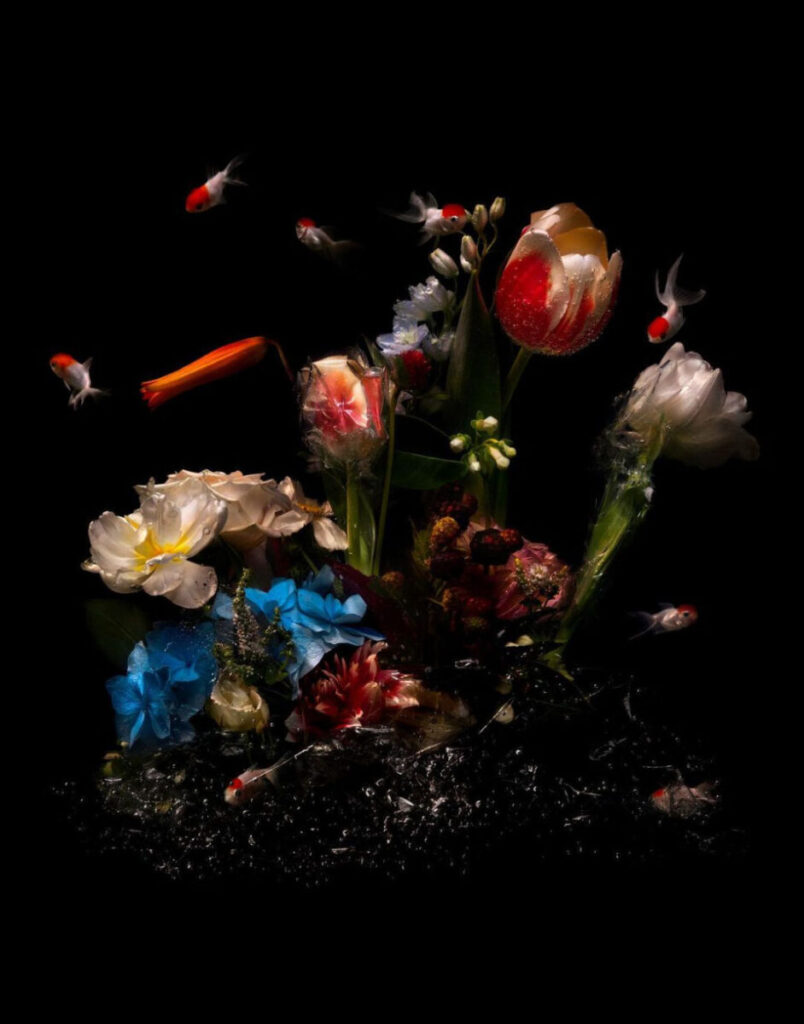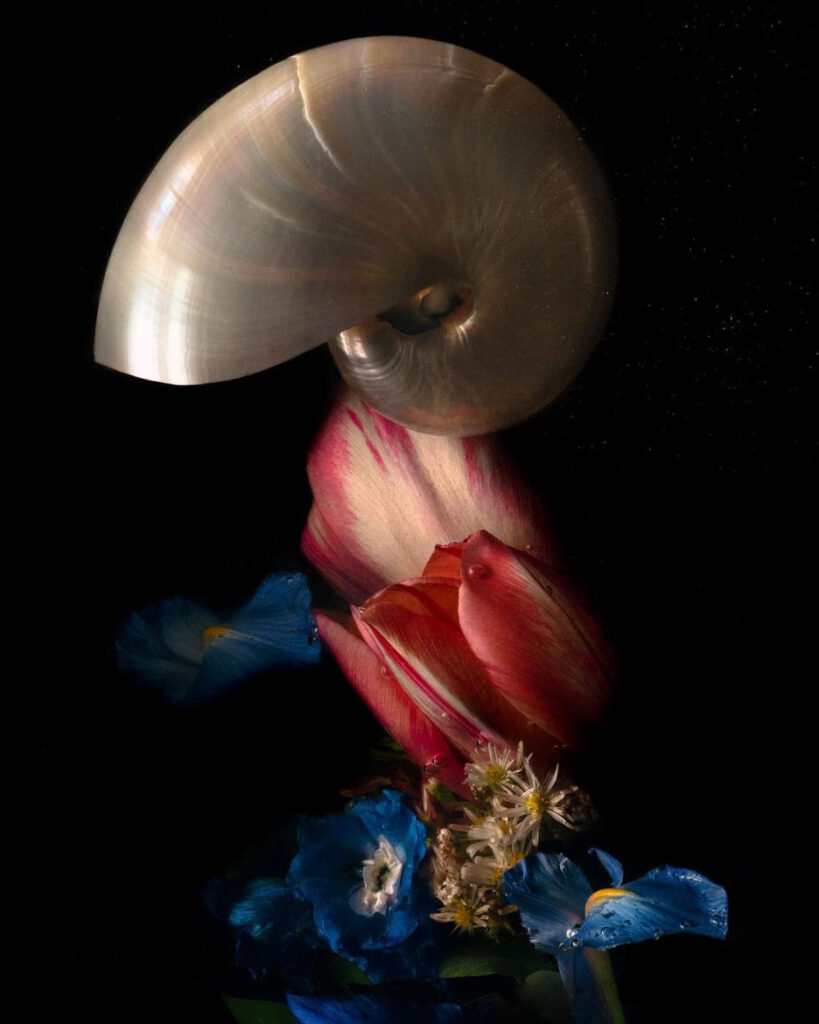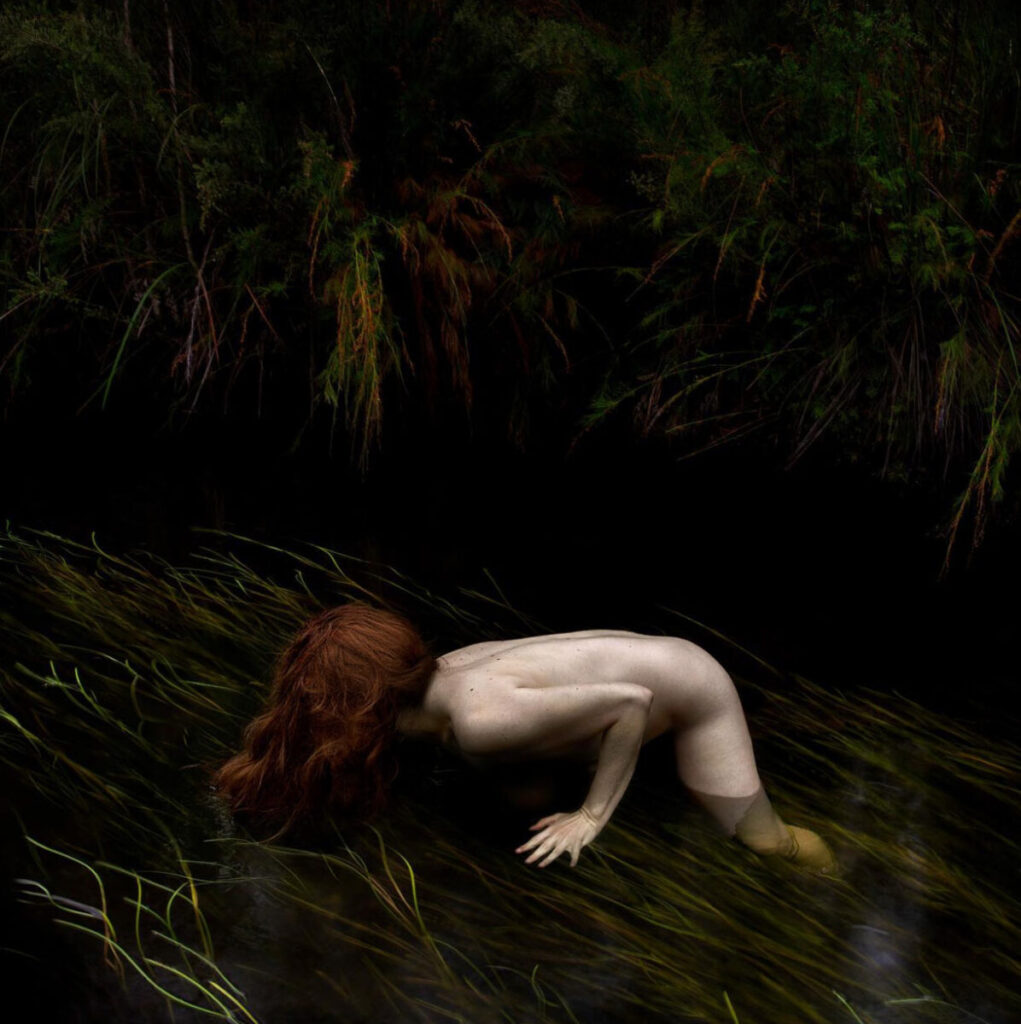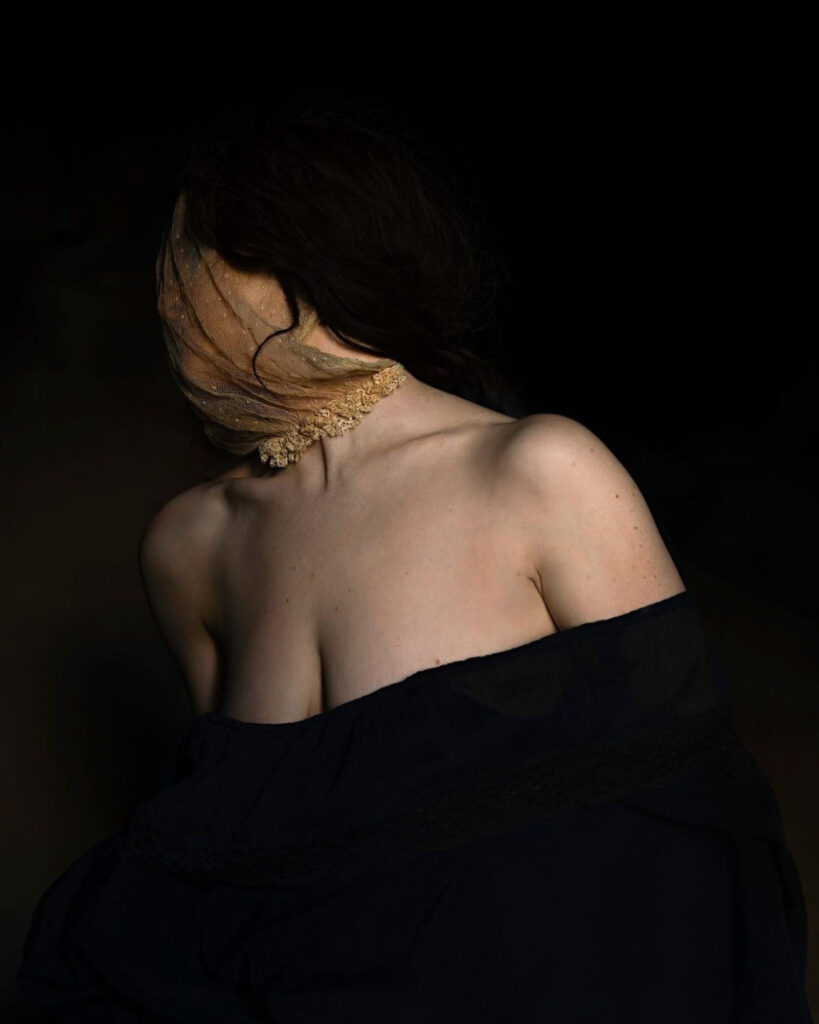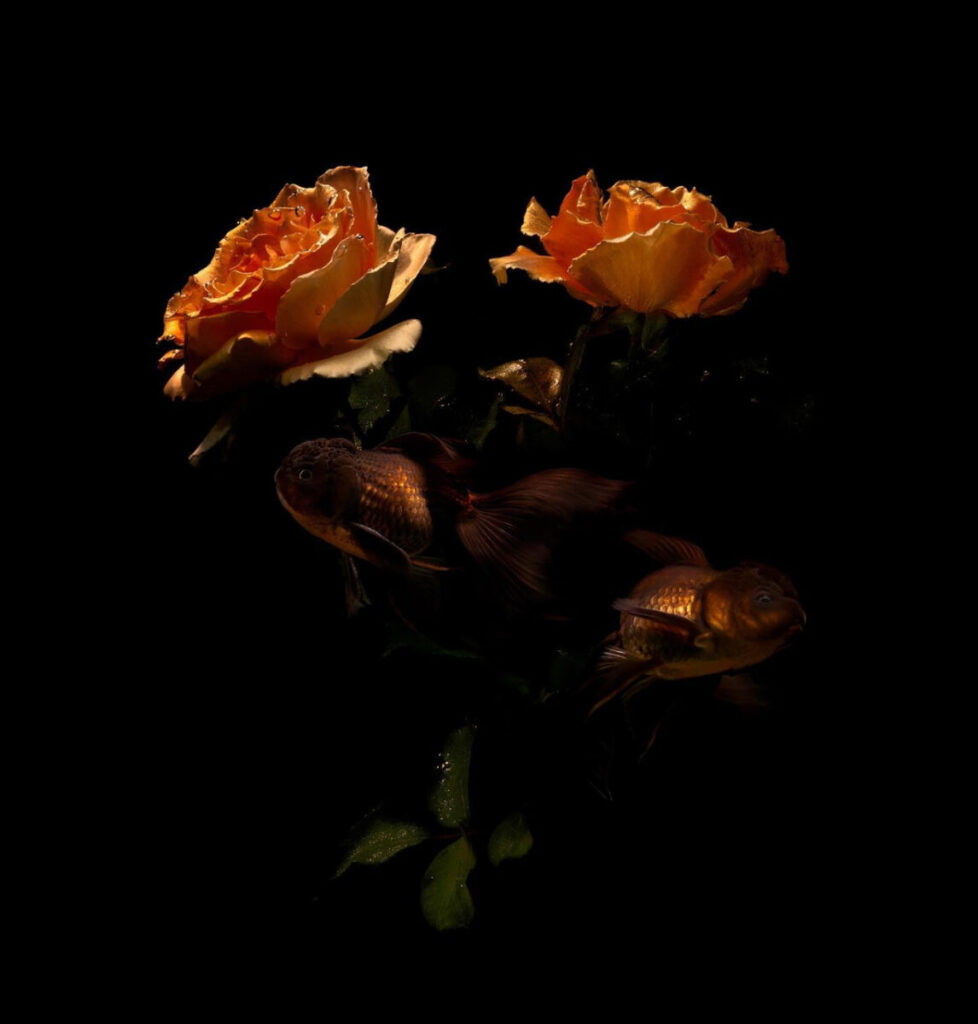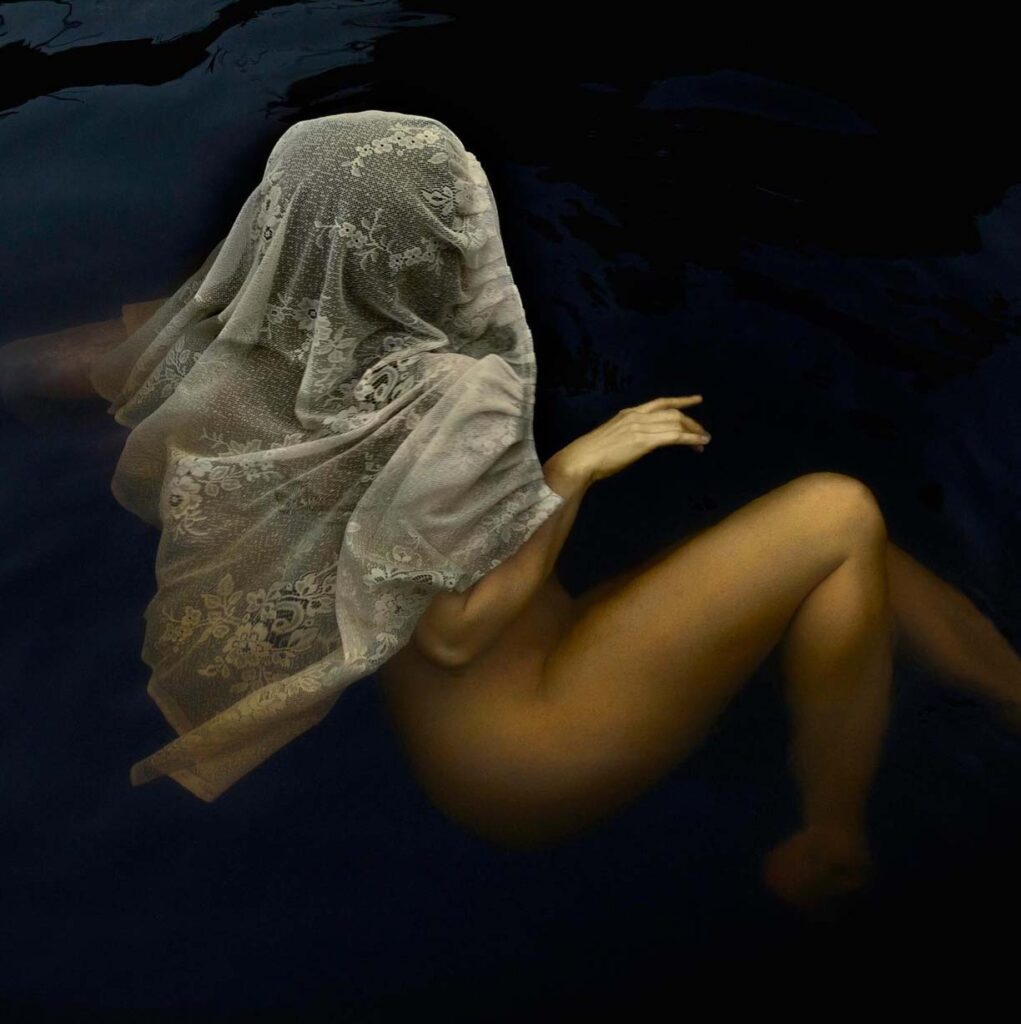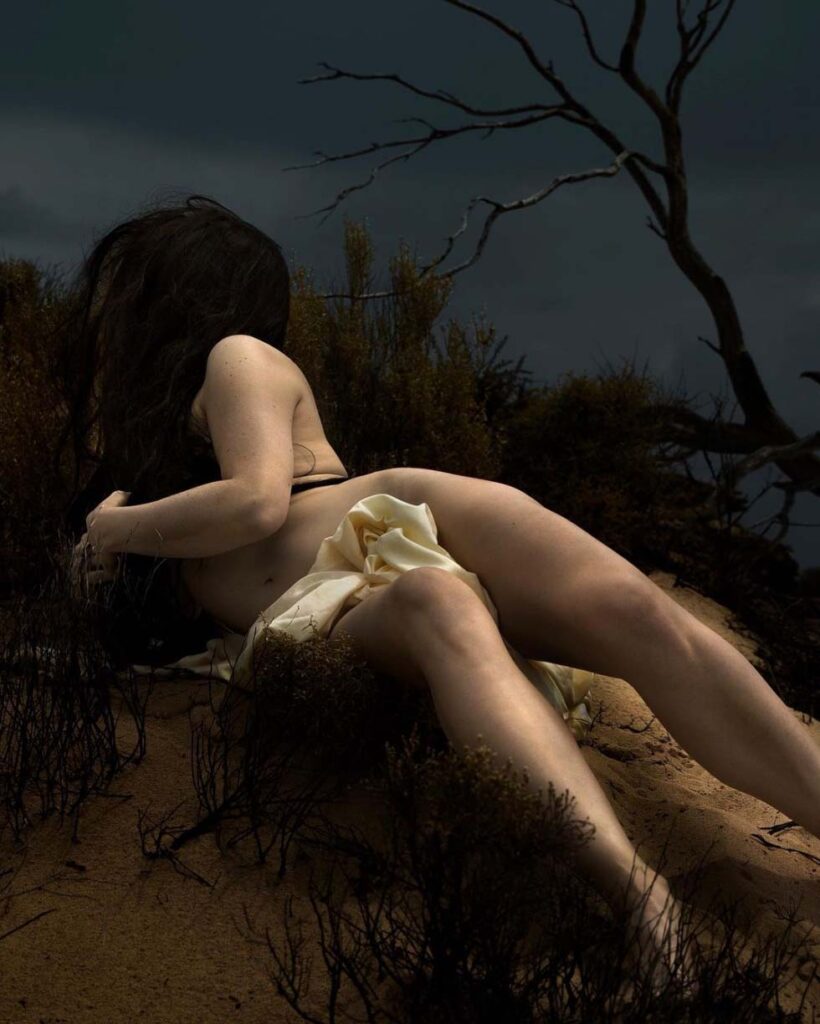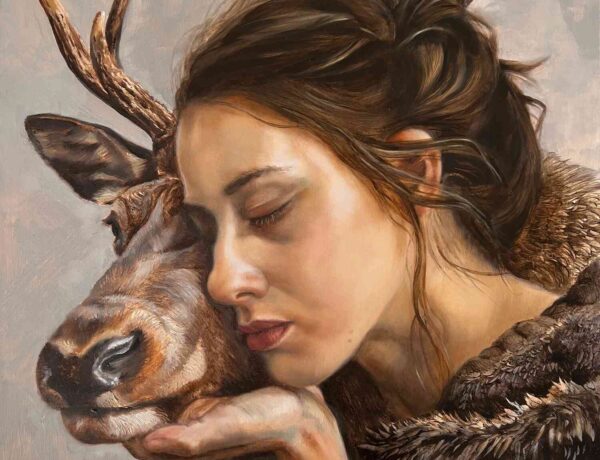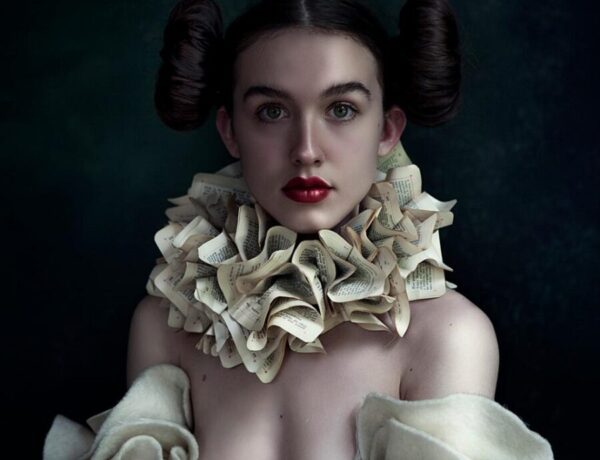Exclusive Interview with Lilli Waters, 2nd Prize Winner of the INPRNT Photography Award, 2022 Beautiful Bizarre Art Prize
Captivating and vivid, Lilli Waters’ photographs are visions of serenity, but beneath the surface lies a message of disenchantment. Her subjects drip with a mythos all Waters’ own, hiding faces and identifying features behind veils and natural elements to create space for the viewer to project their own hopes and fears onto the figures. Inspired by ancient myths, the experience of living in a female body in a society bent on exploitation of the female form, and the growing ecological crisis, Lilli Waters brings a critical feminine lens to her craft, creating imagery that is at once visually alluring and hyperaware of the space in which it exists.
Through her camera, Waters sees an imperfect world filled with visceral loveliness interspersed with the terrors which stalk the nights of our 21st century collective consciousness. With her work, she explores beauty and suffering with the understanding that the two are never as far apart as they may seem. In this exclusive interview, learn more about how Waters came to her craft, the woman behind the lens, and what fans of her work have to look forward to in the future.
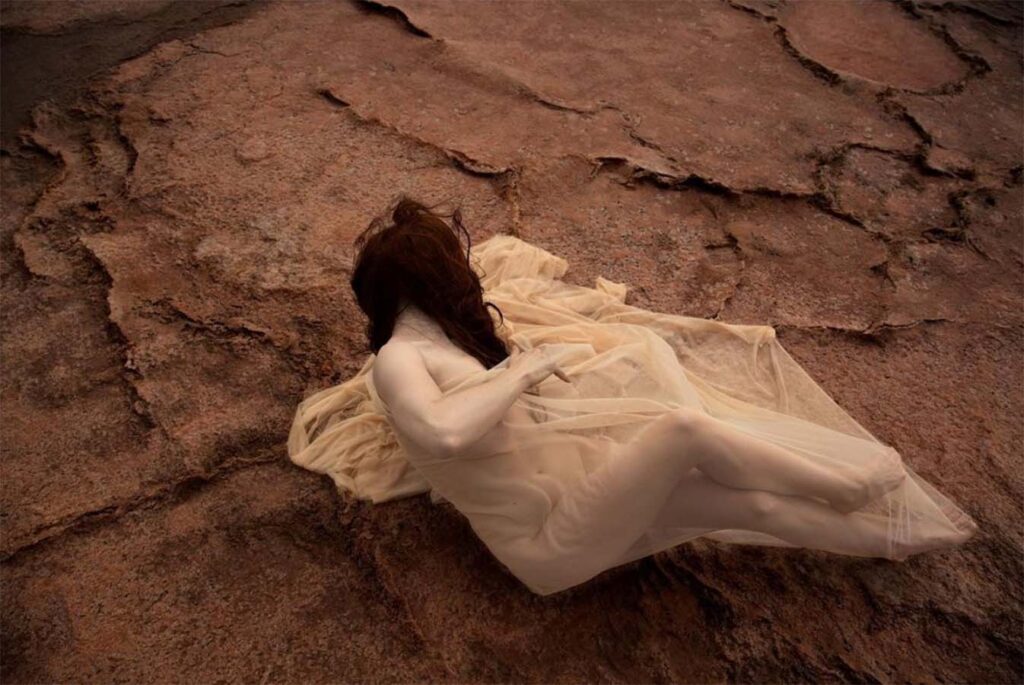
How did you get started in photography?
It was a bit of an accident. I made short films in high school and was invited to go to a filmmaking school, but the class ended up being cancelled as not enough students were attending, so I continued on with the major subject which was photography. It was all dark room printing back then, no one I knew owned a digital camera.
Can you tell us more about the process behind your winning piece, Where Dreams Inhabit? What inspired the piece? How did you choose the title?
‘Where Dreams Inhabit’ is from the series ‘Orpheus’. Offering a nuanced mix of hope and despair, promise and foreboding, this series of photographic vignettes was created during a lockdown reprieve in mid-2021, when Melbourne residents thought they were at last free from government restrictions. After the first few lockdowns, there was a small window of time where we were relatively Covid-free and life returned to some kind of normal. The ideas behind Orpheus emerged from a feeling of excitement, optimism and gratitude to be able to make work, be creative and get out in nature again. Being able to visit these incredible landscapes was a beautiful and surreal experience for me. The title came quite naturally, as this faceless female form reminded me of some kind of dark, beautiful & mysterious dream.
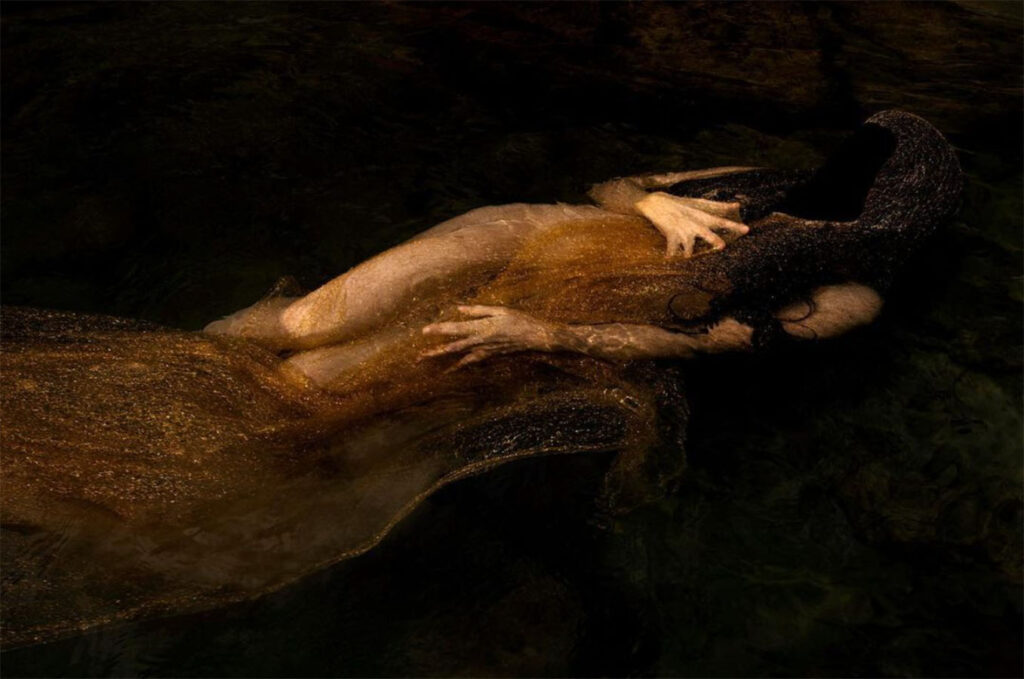
2nd Prize Winner
INPRNT Photography Award Beautiful Bizarre Art Prize 2022
Medium & Dimensions:
Digital photograph (Canon 5D Mark IV, 24-70mm)
‘Where Dreams Inhabit’ is from the series ‘Orpheus’. Offering a nuanced mix of hope and despair, promise and foreboding, this series of photographic vignettes was created during a lockdown reprieve in mid-2021, when Melbourne residents thought they were at last free from government restrictions.
Your work is soft, feminine, beautiful, alluring—yet, you contrast those qualities with darker elements to point to the complex issues facing women in the era of ‘Me Too’ and a world facing ecological crisis. What led you down this pathway artistically?
Whilst I am a lover of aesthetically beautiful fantasy imagery and strongly relate to the feminine, I am also a realist and feel strongly about issues facing how women are treated in society and mass environmental destruction. I come from a long line of strong women activists and environmentalists who suffered at the hands of men, and so if I am going to make work, for me, it is important to me that it explores these themes and holds some kind of message and meaning for others to consider when they look at these works. There is also always some kind of beauty in the darkness, this is something I have had to learn and lean into over the years, that the darkness doesn’t have to be only the fear & dread that comes with the human experience.
Can you take us through how you go about creating a new piece from start to finish?
Whilst planning this body of work, I was unable to go to the shops to source new materials due to lockdowns. I dug the gold netted material out of my fabric box. It became the thread that tied both the female form and underwater still life images for Orpheus together. I planned a week-long trip to Wilsons Promontory National Park, southeast of Melbourne, during a window between lockdowns. My subject and I spent our days driving, scouting, waiting… then shooting, during the small windows of the right light.
We would work at dawn, rising at 4am to venture out when there was no one else around. Then again at dusk when all the tourists had finally gone home. I like to work intensely for many consecutive days, to fully immerse myself in the process. I find the combination of pushing my mind and body to the limit with no distractions and building momentum, takes the work to a different place. It helps me to enter a deeper, more focused frame of mind, which wouldn’t happen if I shot a day here or there.
Orpheus was the first time I was working with the ocean tides, so it added a whole extra layer of challenges, as we had to ensure we didn’t get trapped with camera equipment when the tide came in.
I spent many months in post-production, working on the images and going through a series of test prints together with my printer, before the ten final large scale prints were hung for my solo exhibition in the gallery.
You use elements like fabric and hair to obscure certain features and draw attention to others. How do you select your props? What kind of processes do those go through to be ready for your photographs?
I am always collecting and searching for vintage fabrics, I either hire them or find them in op shops, or if I am looking for something specifically, I purchase them online. Wigs are often hired from my favourite costume shop. Being out in the bush without an assistant doesn’t allow for any steaming or organisation of any kind, so I pull things out whilst on location to see what will work best for that particular landscape.
Your work often draws on the stark contrast between darkness and light to draw attention to specific visual elements. What inspires that contrast?
Paintings are some of my biggest inspirations. I recall flipping through books on Monet, Rembrandt, Caravaggio, and painters from the Pre-Raphaelite era like John William Waterhouse during my years at photography school, they have obviously left a visual imprint on me. The rich colours that emerge from the velvety blackness – the passionate reds, emerald greens, sapphire blues – the harmony and discord, beauty and decay found in so many masterpieces are themes I keep returning to. The atmosphere in my own work can often be both gloomy and tranquil, marbled skin luminous in the dark landscapes offers a contrasting portrait of women, both strong and vulnerable.
My work touches on the fragility and acute vulnerability of our natural world and the devastating impact of humans on our planet. It also questions feminine stereotypes, allowing vulnerability, strength, power, myth, darkness and light to all co-exist.
What do you hope viewers will see when they look at your work?
My work touches on the fragility and acute vulnerability of our natural world and the devastating impact of humans on our planet. It also questions feminine stereotypes, allowing vulnerability, strength, power, myth, darkness and light to all co-exist. I hope that my work can be both a reminder of the magical beauty of nature and also point to an awakening from consumerism and capitalism. We all need to reconnect with nature to be able to discover our true selves. I love this quote by Nina Simone, “You can’t help it. An artists’ duty, as far as I’m concerned, is to reflect the times.”
In addition to your artistic focus on the divine feminine and complexities of feminine identity, you’re also an accomplished still life photographer. What inspires your work with objects?
I get high on the huge old realist oil paintings in museums. It’s like a kind of time travel experiencing these images, so I guess it makes sense that my work leans into this timeless aesthetic. I love to ruminate on the beauty of old-world impressions of nature. I draw inspiration from paintings by the old Dutch masters that I have loved for years, many of these are images of flowers symbolising beauty, nobility and prosperity, which is a major influence in my still life work.
I’ve also been influenced by my mother, a botanical painter who hung paintings of flowers in my childhood home, and my grandmother who liked to collect precious found objects. My still life arrangements often at first appear to be beautifully arranged underwater scenes decorated with Rembrandt-esque blooms. But upon closer inspection, you’ll notice added pieces of litter that literally choke some of the floral arrangements, and the murky blackness that imparts a sense of loneliness. It’s a direct comment on consumerism, human darkness and the rampant quest for prosperity. Prosperity has typically been lauded as something to desire and celebrate, yet now more than ever, the unpleasant complexities of wealth and indulgence are apparent. We nonchalantly poison the environment in pursuit of it.
Is there any image in your repertoire that holds special meaning for you? What about that image do you connect with?
I am not sure that I have a specific favourite image, I have a love-hate relationship with my work, some days I admire it, some days find it hard to connect to. Sometimes it can take me years to like a series. At the moment, I do actually love ‘Where Dreams Inhabit’; I love how the gold threads shimmers out from the darkness, how she looks like she has webbed-fingers, and the way the fabric makes it look like she has an old-world helmet of gold sparkles.
What equipment do you work with to craft your photos?
I use a Canon Mark IV or 5DSR, a sturdy tripod, a stepladder, and a bunch of different lights to experiment with.
Do you have anything exciting planned for the future? What can our readers look forward to seeing from you next?
I am about to embark on creating a new photographic series for a solo exhibition opening in Sydney in 2023. There may be some more exciting news coming soon but it’s still a secret!
What advice would you give to new artists who are just beginning in your medium?
Shoot at every chance that you have and don’t look to other photographers for inspiration too much. Find your own voice.
Why did you enter the Beautiful Bizarre Magazine Art Prize?
I have entered the Beautiful Bizarre Magazine Art Prize for many years and have been fortunate enough to have been a finalist previously and had a feature and interview in the magazine. I am a huge supporter and fan of this art prize and thank them for supporting my work.
To have acknowledgement from this art community and be in the company of so many incredible artists is a great honour.
What do you feel you have gained from this experience?
To have acknowledgement from this art community and be in the company of so many incredible artists is a great honour. Having my work exhibited at the Halycon Days exhibition at Modern Eden Gallery in California is so exciting!
Would you recommend it and encourage others to enter? If so, why?
I would highly recommend entering the Beautiful Bizarre Art Prize, they have such a broad range of different artists and categories, with such a high standard of work and wonderful prizes.


